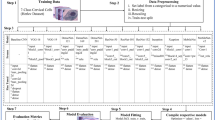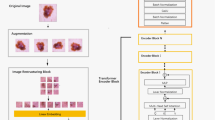Abstract
Skin cancer is the most common type of cancer and represents more than half of cancer diagnoses. Melanoma is the least frequent among skin cancers, but it is the most serious, with high potential for metastasis and can lead to death. However, melanoma is almost always curable if discovered in the early stages. In this context, computational methods for processing and analysis of skin lesion images have been studied and developed. This work proposes a computational approach to assist dermatologists in the diagnosis of skin lesions in melanoma or non-melanoma by means of dermoscopic images. The proposed methodology classifies skin lesions using a descriptor formed by the combination of the ABCD rule (Asymmetry, Border, Color, and Diameter) and pre-trained Convolutional Neural Networks (CNNs) features. The features were selected according to their gain ratios and used as input to the MultiLayer Perceptron classifier. We built a new database joining two distinct databases presented in the literature to validate the proposed methodology. The proposed method achieved an accuracy rate of 94.9% and Kappa index of 89.2%, which is considered “excellent”.






Similar content being viewed by others
References
Al-Akaidi M (2004) Fractal speech processing. Cambridge University Press, Cambridge
Argenziano G, Soyer H, De Giorgi V, Piccolo D, Carli P, Delfino M (2000) Interactive atlas of dermoscopy (book and cd-rom), http://www.dermoscopy.org/atlas/default.asp
Barcelos CAZ, Boaventura M, Silva E (2003) A well-balanced flow equation for noise removal and edge detection. IEEE Trans Image Process 12(7):751–763
Bhati P, Singhal M (2015) Early stage detection and classification of melanoma. In: Communication, control and intelligent systems (CCIS), 2015, pp 181–185. IEEE
Breiman L (2001) Random forests. Mach Learn 45(1):5–32
Campbell Jr JL (2012) Dermnet skin disease atlas, http://www.dermnet.com/
Cavalcanti PG, Scharcanski J (2011) Automated prescreening of pigmented skin lesions using standard cameras. Comput Med Imaging Graph 35(6):481–491
Cavalcanti PG, Scharcanski J, Baranoski GV (2013) A two-stage approach for discriminating melanocytic skin lesions using standard cameras. Expert Syst Appl 40(10):4054–4064
Chang WY, Huang A, Yang CY, Lee CH, Chen YC, Wu TY, Chen GS (2013) Computer-aided diagnosis of skin lesions using conventional digital photography: a reliability and feasibility study. PloS one 8(11):e76,212
Chatfield K, Simonyan K, Vedaldi A, Zisserman A (2014) Return of the devil in the details: Delving deep into convolutional nets. In: British machine vision conference
Chimieski BF, Fagundes RDR (2013) Association and classification data mining algorithms comparison over medical datasets. Journal of health informatics 5(2):44–51
Chu A, Sehgal CM, Greenleaf JF (1990) Use of gray value distribution of run lengths for texture analysis. Pattern Recogn Lett 11(6):415–419
Codella N, Cai J, Abedini M, Garnavi R, Halpern A, Smith JR (2015) Deep learning, sparse coding, and svm for melanoma recognition in dermoscopy images. In: International workshop on machine learning in medical imaging, pp 118–126. Springer, Berlin
Cohen BA, Lehmann CU (2012) Johns hopkins university - dermatlas, dermatology image atlas .http://dermatlas.med.jhmi.edu/derm
Cortes C, Vapnik V (1995) Support-vector networks. Mach Learn 20(3):273–297
Dalal N, Triggs B (2005) Histograms of oriented gradients for human detection. In: Computer vision and pattern recognition, 2005. CVPR 2005. IEEE computer society conference on, vol 1, pp 886–893.IEEE
Dasarathyand BR, Holder EB (1991) Image characterizations based on joint gray-level run-length distributions. Pattern Recogn Lett 12(8):497–502
Diepgen TL, Yihune G (2016) Dermatology information system – dermis. http://dermis.net/, (2012). Accessed September 12
Fix E, Hodges Jr JL (1951) Discriminatory analysis-nonparametric discrimination: consistency properties, Tech. rep., California Univ Berkeley
Galloway MM (1975) Texture analysis using gray level run lengths. Computer graphics and image processing 4(2):172–179
Guide SC (2012) Melanoma. http://www.skincancerguide.ca/melanoma/images/melanoma_images.html
Gutiérrez PA, Hervás-martínez C, Martínez-Estudillo FJ (2011) Logistic regression by means of evolutionary radial basis function neural networks. IEEE Transactions on Neural Networks 22(2):246–263
Hall M, Frank E, Holmes G, Pfahringer B, Reutemann P, Witten IH (2009) The weka data mining software: an update. ACM SIGKDD explorations newsletter 11(1):10–18
Halpern A, Marghoob A, Zemtsov A, Scope A, Kheterpal M (2015) International skin imaging collaboration. https://isic-archive.com/
Haralick RM, Shanmugam K, et al. (1973) Textural features for image classification. IEEE Trans Syst Man Cybern 3(6):610–621
Haykin SS (2009) Neural networks and learning machines, vol 3. Pearson Upper Saddle River, NJ, USA
Jia Y, Shelhamer E, Donahue J, Karayev S, Long J, Girshick R, Guadarrama S, Darrell T (2014) Caffe: Convolutional architecture for fast feature embedding. In: Proceedings of the 22Nd ACM International Conference on Multimedia, MM ’14. New York, USA, pp 675–678
Kasmi R, Mokrani K (2016) Classification of malignant melanoma and benign skin lesions: implementation of automatic abcd rule. IET Image Process 10(6):448–455
Krizhevsky A, Sutskever I, Hinton GE (2012) Imagenet classification with deep convolutional neural networks. In: Pereira F, Burges CJC, Bottou L, Weinberger KQ (eds) Advances in neural information processing systems 25. Curran Associates Inc, pp 1097-1105
Kumar A, Kim J, Lyndon D, Fulham M, Feng D (2016) An ensemble of fine-tuned convolutional neural networks for medical image classification. IEEE Journal of Biomedical and Health Informatics 21:31–40
Lacy K, Alwan W (2013) Skin cancer. Med 41(7):402–405
Landis JR, Koch GG (1977) The measurement of observer agreement for categorical data. Biometrics 33:159–174
Li SZ (2009) Markov random field modeling in image analysis Springer Science & Business Media
Melton JL, Swanson JR (2012) Loyola university dermatology medical education, skin cancer and benign tumor image atlas. http://www.meddean.luc.edu/lumen/MedEd/medicine/dermatology/melton/content1.html
Mendonça T, Ferreira PM, Marques JS, Marcal AR, Rozeira J (2013) Ph2-a dermoscopic image database for research and benchmarking. In: Engineering in Medicine and Biology Society (EMBC), 2013 35th Annual International Conference of the IEEE, pp 5437–5440. IEEE. https://www.fc.up.pt/addi/ph2
Ojala T, Pietikäinen M, Harwood D (1996) A comparative study of texture measures with classification based on featured distributions. Pattern Recognit 29(1):51–59
Oliveira RB, Marranghello N, Pereira AS, Tavares JMR (2016) A computational approach for detecting pigmented skin lesions in macroscopic images. Expert Syst Appl 61:53–63
Powers D (2007) Evaluation: from precision, recall and f-factor to roc, informedness, markedness and correlation. Adelaide, Australia
Rosenfield GH, Fitzpatrick-Lins K (1986) A coefficient of agreement as a measure of thematic classification accuracy. Photogrammetric engineering and remote sensing 52(2):223–227
Rumelhart DE, Hinton GE, Williams RJ (1985) Learning internal representations by error propagation. Tech. rep. California Univ San Diego La Jolla Inst for Cognitive Science
Sánchez-Monedero J, Sáez A, Pérez-Ortiz M, Gutiérrez PA, Hervás-martínez C (2016) Classification of melanoma presence and thickness based on computational image analysis. In: International conference on hybrid artificial intelligence systems, pp 427–438. Springer, Berlin
SCF (2017) Skin cancer & facts statistics. http://www.skincancer.org/skin-cancer-information/skin-cancer-facts, Accessed May 15
Simonyan K, Zisserman A (2014) Very deep convolutional networks for large-scale image recognition. arXiv:1409.1556
Sobel I (1970) Camera models and machine perception. Tech. rep., DTIC Document
Society AC (2018) Cancer facts and figures 2018. https://www.cancer.org/content/dam/cancer-org/research/cancer-facts-and-statistics/annual-cancer-facts-and-figures/2018/cancer-facts-and-figures-2018.pdf. Accessed May 3, 2018
Suzumura Y (2012) Ysp dermatology image database. http://homepage1.nifty.com/ysh/soft_e_ysp.htm
Tajbakhsz N, Shin JY, Gurudu SR, Hurst RT, Kendall CB, Gotway MB, Liang J (2016) Convolutional neural networks for medical image analysis: Full training or fine tuning? IEEE Trans Med Imaging 35:1299–1312
Tamura H, Mori S, Yamawaki T (1978) Textural features corresponding to visual perception. IEEE Transactions on Systems Man, and Cybernetics 8(6):460–473
Total S (2012) Câncer da pele: fotoproteção, vida saudável com o sol. http://www.saudetotal.com.br/prevencao/topicos/default.asp
UK CR (2017) Skin cancer. http://www.cancerresearchuk.org/about-cancer/skin-cancer. Accessed March 15, 2018
Vogado LH, Veras RM, Araujo FH, Silva RR, Aires KR (2018) Leukemia diagnosis in blood slides using transfer learning in CNNs and SVM for classification. Eng Appl Artif Intell 72:415–422. https://doi.org/10.1016/j.engappai.2018.04.024. https://www.sciencedirect.com/science/article/pii/S0952197618301039
Wang SH, Sun J, Phillips P, Zhao G, Zhang YD (2017) Polarimetric synthetic aperture radar image segmentation by convolutional neural network using graphical processing units. Journal of Real-Time Image Processing, pp 1–12. https://doi.org/10.1007/s11554-017-0717-0.
WHO How common is skin cancer? http://www.who.int/uv/faq/skincancer/en/index1.html. Accessed May 15, 2017
Zhang YD, Dong Z, Chen X, Jia W, Du S, Muhammad K, Wang SH (2017) Image based fruit category classification by 13-layer deep convolutional neural network and data augmentation. Multimedia Tools and Applications. https://doi.org/10.1007/s11042-017-5243-3.
Zhang Y.D, Muhammad K, Tang C (2018) Twelve-layer deep convolutional neural network with stochastic pooling for tea category classification on gpu platform. Multimedia Tools and Applications. https://doi.org/10.1007/s11042-018-5765-3.
Author information
Authors and Affiliations
Corresponding author
Additional information
Publisher’s Note
Springer Nature remains neutral with regard to jurisdictional claims in published maps and institutional affiliations.
Rights and permissions
About this article
Cite this article
Moura, N., Veras, R., Aires, K. et al. ABCD rule and pre-trained CNNs for melanoma diagnosis. Multimed Tools Appl 78, 6869–6888 (2019). https://doi.org/10.1007/s11042-018-6404-8
Received:
Revised:
Accepted:
Published:
Issue Date:
DOI: https://doi.org/10.1007/s11042-018-6404-8




